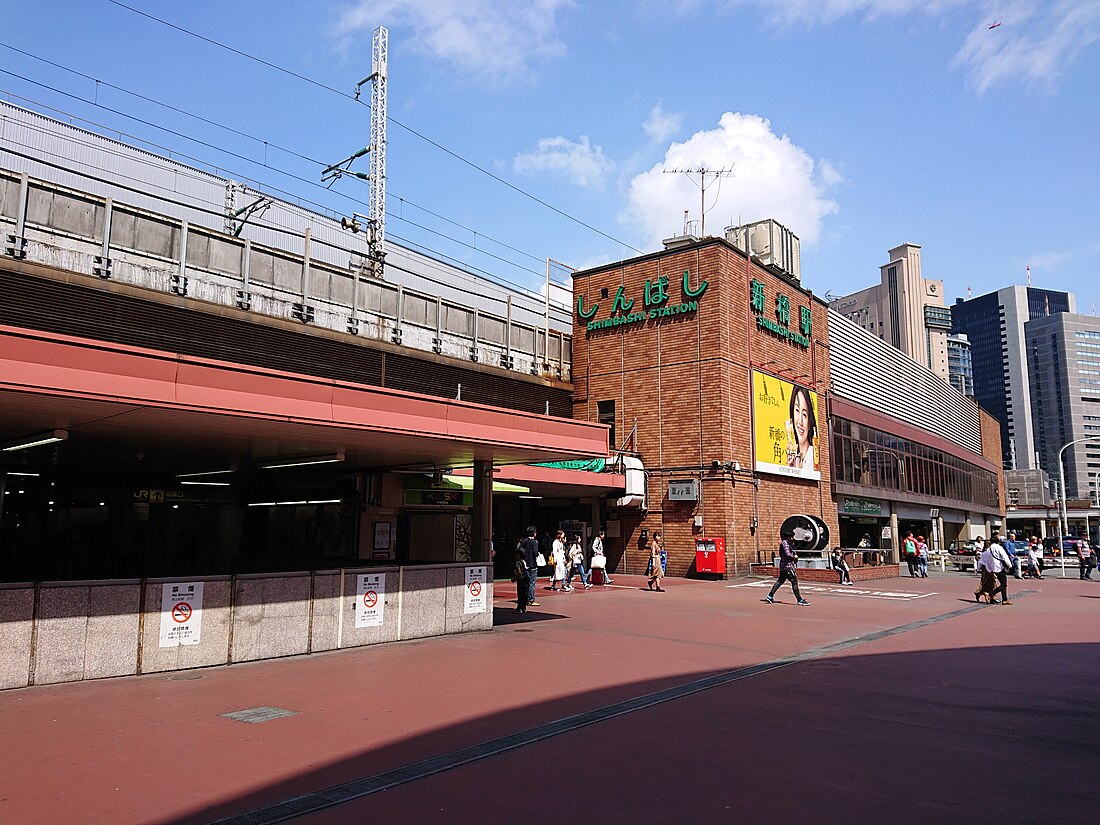Top Qs
Timeline
Chat
Perspective
Shimbashi Station
Railway and metro station in Tokyo, Japan From Wikipedia, the free encyclopedia
Remove ads
Shimbashi Station (新橋駅, Shinbashi-eki) is a major interchange railway station in Tokyo's Minato Ward, located centrally and a 10-minute walk from the Ginza shopping district, directly south of Tokyo station.
Many train services such as limited express trains (except the Shōnan (train) service) and the JR East Keihin-Tōhoku Line rapid trains do not stop at this station. It is also served by Toei Subway's Asakusa Line and Tokyo Metro's Ginza Line. It is also relatively close to Uchisaiwaicho Station on the Toei Mita Line (located 230 meters to the northwest), although it is not officially recognized as a transfer station and there is no transfer corridor between the two stations.
Remove ads
Station layout
Summarize
Perspective
JR East
The JR East station consists of three surface platforms serving the Tōkaidō, Yamanote, and Keihin-Tōhoku lines, and an underground platform serving the Yokosuka Line.
Surface platforms
| 1 | JT Tōkaidō Main Line | for Yokohama, Odawara, and Atami |
| 2 | JU Ueno-Tokyo Line | for Tokyo and Ueno (via JU Utsunomiya Line) for Omiya, Utsunomiya (via JU Takasaki Line) for Takasaki (via JJ Jōban Line) for Toride, Mito |
| 3 | JK Keihin-Tōhoku Line | for Shinagawa, Yokohama, and Ofuna |
| 4 | JY Yamanote Line | for Shinagawa, Shibuya, and Shinjuku |
| 5 | JY Yamanote Line | for Tokyo, Ueno, and Ikebukuro |
| 6 | JK Keihin-Tōhoku Line | for Tokyo, Ueno, and Ōmiya |
- Platforms 1 and 2
- Platforms 3 and 4
- Platforms 5 and 6
Underground platform
| 1 | JO Yokosuka Line | for Yokohama, Ofuna, and Kurihama |
| 2 | JO Yokosuka Line | for Tokyo, Funabashi, and Chiba |
- Yokosuka Line platforms
Tokyo Metro
Tokyo Metro operates in an underground station with two side platforms serving the Tokyo Metro Ginza Line.
| 1 | G Ginza Line | for Akasaka-mitsuke and Shibuya |
| 2 | G Ginza Line | for Ginza, Ueno, and Asakusa |
- Ticket gates
- Platform 2
Tokyo Metropolitan Bureau of Transportation (Toei)
Toei operates in an underground station with two side platforms serving the Toei Asakusa Line.
| 1 | A Asakusa Line | for Sengakuji and Nishi-Magome KK Keikyu Main Line for Haneda Airport Terminal 1·2 and Misakiguchi |
| 2 | A Asakusa Line | for Nihombashi and Oshiage KS Keisei Main Line for Aoto, Keisei Takasago, Keisei Sakura, Keisei Narita, and Narita Airport (Terminal 2·3 and Terminal 1) HS Hokusō Line for Imba Nihon-idai KS Narita Sky Access Line for Narita Airport SR Shibayama Railway Line for Shibayama-Chiyoda |
- Platforms
Yurikamome
The terminus for the Yurikamome is an elevated station next to the JR station.
| 1/2 | for Daiba, Tokyo Big Sight, Shijō-mae, and Toyosu |
- Yurikamome Shimbashi Station entrance, 2019
- Platforms, January 2020
Remove ads
History
Summarize
Perspective

Shimbashi is the original terminus of Japan's first stretch of railway, the Tōkaidō Main Line, and is one of Japan's oldest stations (the oldest station being Shinagawa, a few kilometres down the line). The original Shimbashi Station, opened on October 10, 1872, was built some way to the east of the modern-day structure and was known as Shimbashi Teishajō (新橋停車場).
The present-day structure opened on 16 December 1909 as Karasumori Station (烏森駅) on the Yamanote Line.[1] With the extension of the Tōkaidō Main Line along its modern-day route to the new terminus at Tokyo Station in 1914, the original station was demolished to make way for a freight yard, Shiodome Station (汐留駅), and Karasumori Station was renamed Shimbashi Station.
Japan's first subway line, operated by the Tokyo Underground Railroad Company, was extended to Shimbashi in 1934. In January 1939, the Tokyo Rapid Railway Company built a second subway station at Shimbashi for its line from Shibuya. After several months, the lines were merged to allow through service, and the TRR station was closed. In 1941 the two companies merged forming today's Tokyo Metro Ginza Line. The Ginza Line operated from a single platform until 1980, when a second parallel platform was opened to relieve congestion.
The Toei Asakusa Line began service to Shimbashi in 1968, and the elevated Yurikamome station opened in 1995.[2]
Shiodome Station closed in 1986. The site was declared a national monument in 1996 and the area was archeologically investigated while being redeveloped as a commercial district ("Shiosite") with a number of large office blocks. In 2003 a reconstruction of the original Shimbashi Station building and part of the platforms was completed. It currently houses a railway history exhibit and a restaurant.
The station facilities of the Ginza Line were inherited by Tokyo Metro after the privatization of the Teito Rapid Transit Authority (TRTA) in 2004.[3]
PASMO smart card coverage at this station began on 18 March 2007.[4]
Remove ads
Passenger statistics
In fiscal 2013, the JR East station was used by an average of 254,945 passengers daily (boarding passengers only), making it the seventh busiest station operated by JR East.[5]
The JR East passenger figures for previous years are as shown below.
See also
References
External links
Wikiwand - on
Seamless Wikipedia browsing. On steroids.
Remove ads













